外研版八年级英语上册Module 9 PopulationUnit 3-1教学课件(共31张PPT)
文档属性
| 名称 | 外研版八年级英语上册Module 9 PopulationUnit 3-1教学课件(共31张PPT) |  | |
| 格式 | pptx | ||
| 文件大小 | 1.8MB | ||
| 资源类型 | 教案 | ||
| 版本资源 | 外研版 | ||
| 科目 | 英语 | ||
| 更新时间 | 2022-10-14 21:08:12 | ||
图片预览


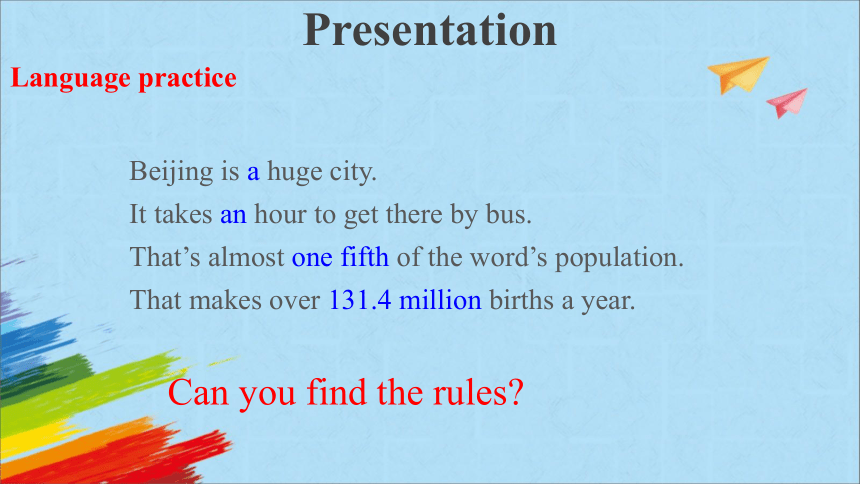
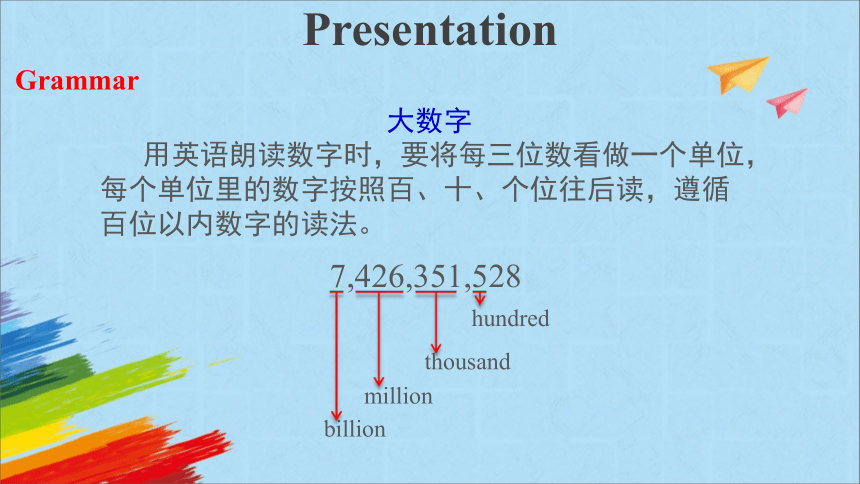
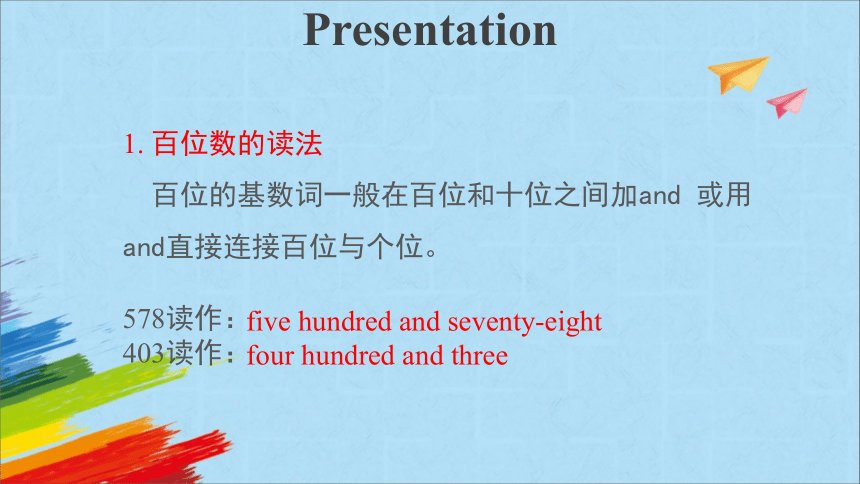
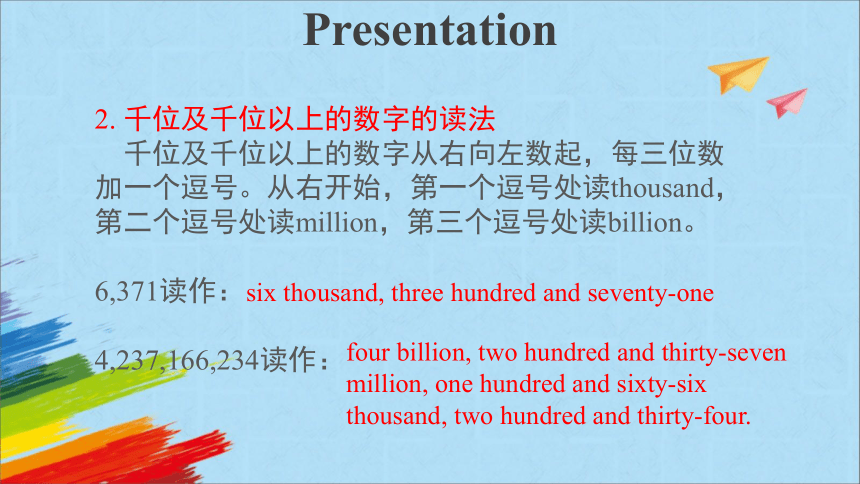
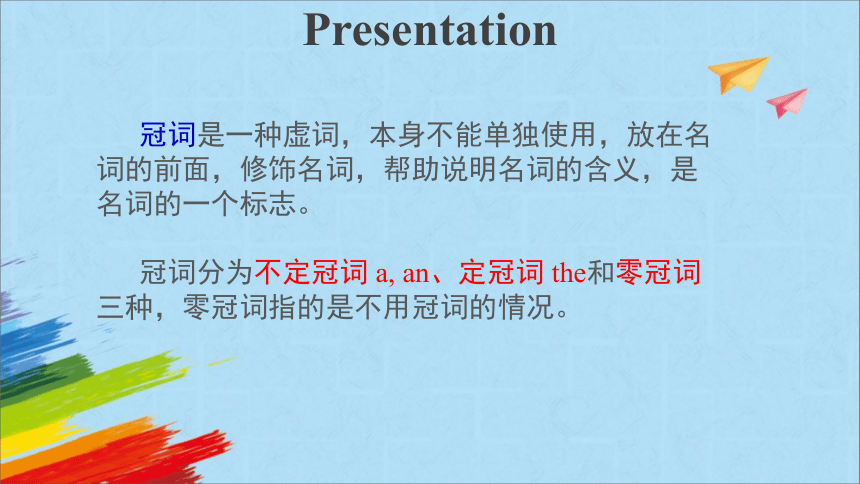
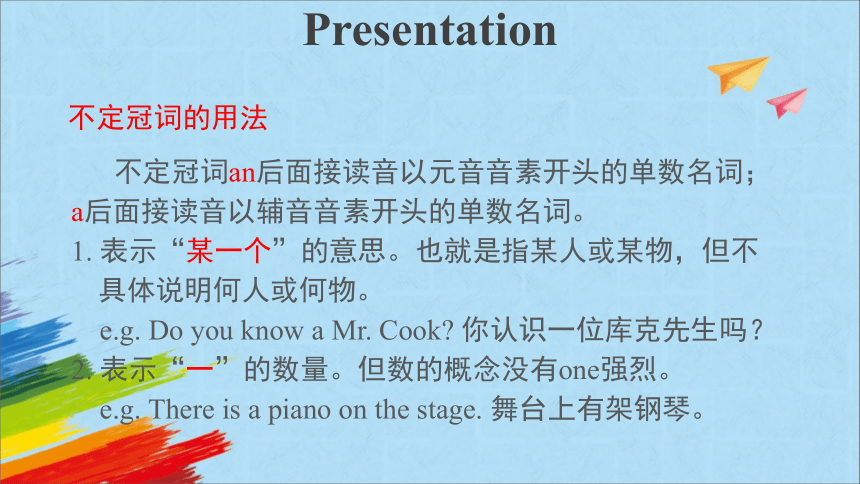
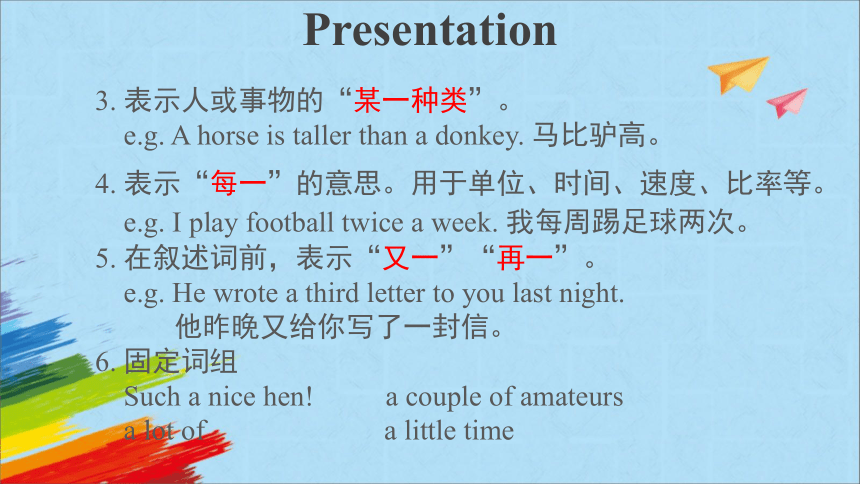
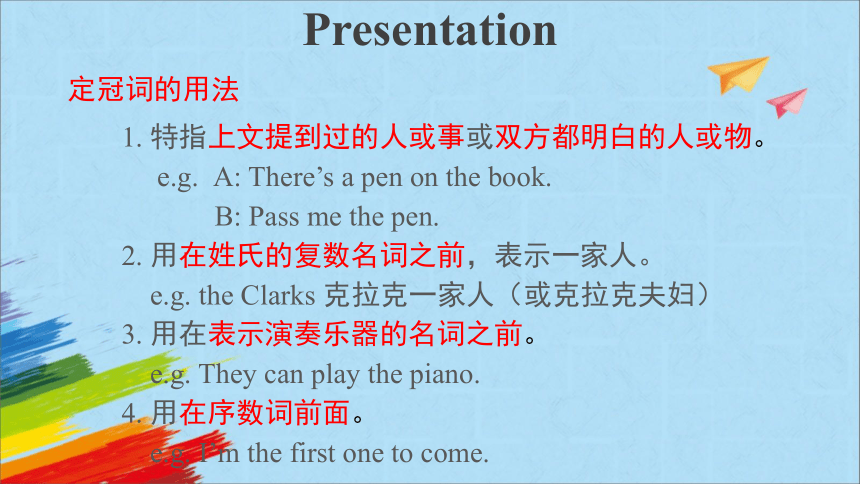

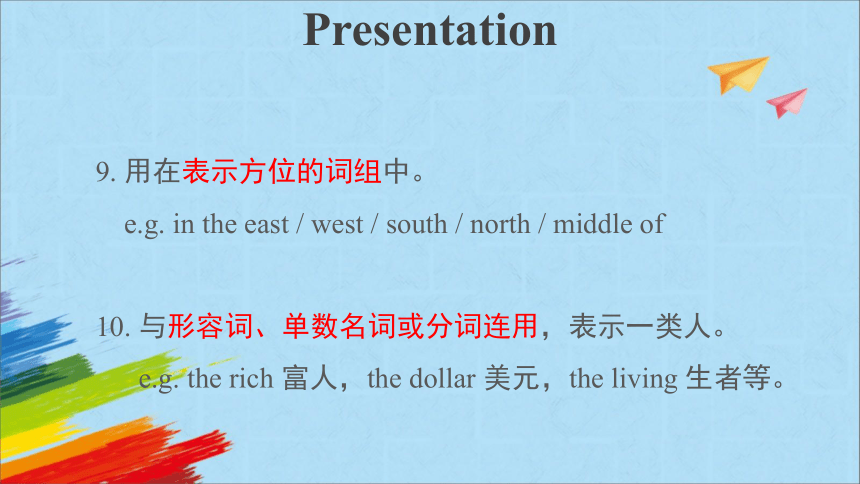
文档简介
(共31张PPT)
Module 9
Population
Unit 3 Language in use 1
1. Beijing is huge city with large population.
2. Population is a big problem in many countries.
3. The population of China is about 1.37 .
4. When Jo’s grandfather first came to Parkville, it was a ______ village.
5. It takes hour to get there by bus.
6. It needs fresh air, clean water and better services.
billion
a
increase
quiet
完成句子。
an
public
Revision
Revision
Can you find the rules
Beijing is a huge city.
It takes an hour to get there by bus.
That’s almost one fifth of the word’s population.
That makes over 131.4 million births a year.
Presentation
Language practice
大数字
用英语朗读数字时,要将每三位数看做一个单位,每个单位里的数字按照百、十、个位往后读,遵循百位以内数字的读法。
7,426,351,528
billion
hundred
thousand
million
Presentation
Grammar
1. 百位数的读法
百位的基数词一般在百位和十位之间加and 或用and直接连接百位与个位。
578读作:
403读作:
five hundred and seventy-eight
four hundred and three
Presentation
2. 千位及千位以上的数字的读法
千位及千位以上的数字从右向左数起,每三位数加一个逗号。从右开始,第一个逗号处读thousand,第二个逗号处读million,第三个逗号处读billion。
6,371读作:
4,237,166,234读作:
six thousand, three hundred and seventy-one
four billion, two hundred and thirty-seven million, one hundred and sixty-six thousand, two hundred and thirty-four.
Presentation
冠词是一种虚词,本身不能单独使用,放在名词的前面,修饰名词,帮助说明名词的含义,是名词的一个标志。
冠词分为不定冠词 a, an、定冠词 the和零冠词三种,零冠词指的是不用冠词的情况。
Presentation
不定冠词的用法
不定冠词an后面接读音以元音音素开头的单数名词;a后面接读音以辅音音素开头的单数名词。
1. 表示“某一个”的意思。也就是指某人或某物,但不具体说明何人或何物。
e.g. Do you know a Mr. Cook 你认识一位库克先生吗?
2. 表示“一”的数量。但数的概念没有one强烈。
e.g. There is a piano on the stage. 舞台上有架钢琴。
Presentation
3. 表示人或事物的“某一种类”。
e.g. A horse is taller than a donkey. 马比驴高。
4. 表示“每一”的意思。用于单位、时间、速度、比率等。
e.g. I play football twice a week. 我每周踢足球两次。
5. 在叙述词前,表示“又一”“再一”。
e.g. He wrote a third letter to you last night.
他昨晚又给你写了一封信。
6. 固定词组
Such a nice hen! a couple of amateurs
a lot of a little time
Presentation
定冠词的用法
1. 特指上文提到过的人或事或双方都明白的人或物。
e.g. A: There’s a pen on the book.
B: Pass me the pen.
2. 用在姓氏的复数名词之前,表示一家人。
e.g. the Clarks 克拉克一家人(或克拉克夫妇)
3. 用在表示演奏乐器的名词之前。
e.g. They can play the piano.
4. 用在序数词前面。
e.g. I’m the first one to come.
Presentation
5. 用在形容词最高级,或形容词 only, very, same等前面。
e.g. That’s the very thing I’ve been looking for.
那正是我要找的东西。
6. 指世上独一无二的事物。
e.g. the sun, the moon, the sky, the earth
7. 用在某些由普通名词构成的专有名词前。
e.g. the United States, the Great Wall
8. 用在下列惯用语中。
e.g. in the 21st century, in the 1980s, catch me by the arm, in the
day / morning等。
Presentation
9. 用在表示方位的词组中。
e.g. in the east / west / south / north / middle of
10. 与形容词、单数名词或分词连用,表示一类人。
e.g. the rich 富人,the dollar 美元,the living 生者等。
Presentation
零冠词的用法
1. 在三餐、学科、语言、球类运动、棋类游戏和娱乐运动的名称前,不加冠词。
e.g. have breakfast / math / chemistry / basketball / chess
2. 在季节、月份、节日、假日、日期、星期等表示时间的名词之前,不加冠词。
e.g. We go to school from Monday to Friday.
3. 在表示人名,头衔,职务,称号前,在地名,国名,城市,街道,标题类和字首为Mount的山及大多数湖泊的专有名词前不用冠词。
e.g. Mount Blanc (白朗峰) Lake Baikal (贝加尔湖)
Presentation
4. 泛指、类指的复数名词,抽象名词、物质名词表示一般概念时常不加冠词。
e.g. Books are my best friends.
5. 前面已有物主代词、指示代词、不定代词、数量词等时不再用冠词。
如this, that, these, those, some, any, no, each, every,another, other, most, last, next, a lot of, a kind of等。
6. 固定搭配
e.g. by bus, by plane, got to school, go to bed, in red
Presentation
在某些短语中,名词前用冠词和不用冠词的意义有所不同:
in hospital 生病住院
in the hospital 在医院(工作或参观等)
at table 在吃饭
at the table 在桌子旁
in class 在上课
in the class 在班级中
Presentation
1. —What do you think of ______ party last night
—Great! All of us had _____ good time.
A. a; a B. the; the C. the; a D. a; the
2. Shenzhen is on _____ coast near Hong Kong. It was _____ small village
many years ago.
A. a; the B. the; a C. 不填; 不填 D. the; the
3. There is _____ old piano in _____ corner of the living room.
A. an; the B. an; 不填 C. a; the D. a; a
Practice
Grammar exercises
1. China
2. the US
3. Australia
4. New Zealand
a) 4,437,000
b) 22,956,000
c) 314,791,000
d) 1,370,537,000
Practice
Work in pairs. Match the countries with their populations.
China has a population of …
The US has a population of …
Now listen and check.
1. China
2. the US
3. Australia
4. New Zealand
a) 4,437,000
b) 22,956,000
c) 314,791,000
d) 1,370,537,000
Practice
Read your answers to Activity 1 to the whole class.
5
10
15
20
25
30
35
40
2000
2025
(million)
Kolkata
Mumbai
New York
Mexico City
Tokyo
population
13.1
18.7
16.4
26.6
17.8
23.6
18
24.6
34.4
38.7
Practice
Read the chart and answer the questions.
1. Which city had the largest population in 2000
Tokyo.
2. Which city’s population will increase the most from 2000 to 2025
Mumbai.
3. Which city will have a larger increase in its population, New York or Mexico City
Mexico City.
4. Which city / cities do you think will have the biggest population problem Why
I think Mumbai will have the biggest population problem because its population will increase faster.
Practice
Answer the following questions.
Mina is 1.____ eighteen-year-old girl. She’s got 2.____ brother and 3.____ sister. Mina is 4.____ oldest child in 5._____ family. She lives in 6.____ very big city. She has 7.___ job in 8.____ hotel. She hopes that one day she will have 9.___ chance to go to 10.___ college.
an
the
a
a
the
a
a
a
a
Practice
Complete the passage with a, an or the where necessary.
1) We believe the schools in Arnwick are very good, and we’re working to make them even _______.
2) Their flat is too large for two people. They want to find a _______ one.
3) Anna always talks about her ideas. I think she needs to listen ________.
4) There are a lot of parks in this city. I think there are ______ parks in a lot of other cities.
few good much small
better
smaller
more
fewer
Practice
Complete the sentences with the correct form of the words in the box.
air city countryside hospital increase
public service traffic water
Practice
Complete the diagram showing population problems. Use the words in the box to help you.
Environmental problems
Examples:
Health problems
Examples:
Problems for government
Examples:
People move from .
People arrive in .
Problem: Population .
Problems of Arnwick
the countryside
the city
increases
air pollution, too much traffic
water pollution, rubbish(crowded flats)
not enough hospitals
need more schools and buses, better public services, more police to protect people
Practice
On ___ fine morning in May, my classmates and I went to visit ____ university. It is one of ______ biggest universities in our city. We saw ______ students of ______ university were studying. We talked with ______ old professor. He told us a lot about his university. At half past ten we said goodbye to ______ professor of ______ university and came back to ______ school. We had a good time that day because we learned a lot from ______ visit.
a
a
the
the
the
an
the
the
/
the
一、根据需要在短文空格中填入适当的冠词。
Production
Do the exercises.
1. I’m going to see my mother. She is ill ____.
A. in hospital B. in the hospital
C. in a hospital D. at a hospital
2. We have three meals ______ day. We have _______ breakfast at 6:30 in ______ morning every day.
A. the, the, the B. the, /, the
C. a, /, the D. a, the, the
√
√
二、单项选择。
Production
3. Can you see ______ one-eyed cow in ______ field
A. an; the B. a; the C. /; the D. a; a
4. My friend Bob likes to play ______ basketball before ______ supper.
A. the; the B. /; the C. the; / D. /; /
√
√
Production
5. ______ Guangzhou today is more beautiful now. Mr. Jackson said he would visit it ______ third time.
A. The; a B. The; the C. /; a D. /; the
6. I think this is ______ useful dictionary.
A. very a B. very an C. quite a D. quite an
√
√
Production
1. How to read the large number
2. 冠词的用法
(1) 不定冠词a / an 的用法;
(2) 定冠词the 的用法;
(3) 零冠词的用法。
Summary
Review the grammar we have learnt today.
Homework
Goodbye!
Module 9
Population
Unit 3 Language in use 1
1. Beijing is huge city with large population.
2. Population is a big problem in many countries.
3. The population of China is about 1.37 .
4. When Jo’s grandfather first came to Parkville, it was a ______ village.
5. It takes hour to get there by bus.
6. It needs fresh air, clean water and better services.
billion
a
increase
quiet
完成句子。
an
public
Revision
Revision
Can you find the rules
Beijing is a huge city.
It takes an hour to get there by bus.
That’s almost one fifth of the word’s population.
That makes over 131.4 million births a year.
Presentation
Language practice
大数字
用英语朗读数字时,要将每三位数看做一个单位,每个单位里的数字按照百、十、个位往后读,遵循百位以内数字的读法。
7,426,351,528
billion
hundred
thousand
million
Presentation
Grammar
1. 百位数的读法
百位的基数词一般在百位和十位之间加and 或用and直接连接百位与个位。
578读作:
403读作:
five hundred and seventy-eight
four hundred and three
Presentation
2. 千位及千位以上的数字的读法
千位及千位以上的数字从右向左数起,每三位数加一个逗号。从右开始,第一个逗号处读thousand,第二个逗号处读million,第三个逗号处读billion。
6,371读作:
4,237,166,234读作:
six thousand, three hundred and seventy-one
four billion, two hundred and thirty-seven million, one hundred and sixty-six thousand, two hundred and thirty-four.
Presentation
冠词是一种虚词,本身不能单独使用,放在名词的前面,修饰名词,帮助说明名词的含义,是名词的一个标志。
冠词分为不定冠词 a, an、定冠词 the和零冠词三种,零冠词指的是不用冠词的情况。
Presentation
不定冠词的用法
不定冠词an后面接读音以元音音素开头的单数名词;a后面接读音以辅音音素开头的单数名词。
1. 表示“某一个”的意思。也就是指某人或某物,但不具体说明何人或何物。
e.g. Do you know a Mr. Cook 你认识一位库克先生吗?
2. 表示“一”的数量。但数的概念没有one强烈。
e.g. There is a piano on the stage. 舞台上有架钢琴。
Presentation
3. 表示人或事物的“某一种类”。
e.g. A horse is taller than a donkey. 马比驴高。
4. 表示“每一”的意思。用于单位、时间、速度、比率等。
e.g. I play football twice a week. 我每周踢足球两次。
5. 在叙述词前,表示“又一”“再一”。
e.g. He wrote a third letter to you last night.
他昨晚又给你写了一封信。
6. 固定词组
Such a nice hen! a couple of amateurs
a lot of a little time
Presentation
定冠词的用法
1. 特指上文提到过的人或事或双方都明白的人或物。
e.g. A: There’s a pen on the book.
B: Pass me the pen.
2. 用在姓氏的复数名词之前,表示一家人。
e.g. the Clarks 克拉克一家人(或克拉克夫妇)
3. 用在表示演奏乐器的名词之前。
e.g. They can play the piano.
4. 用在序数词前面。
e.g. I’m the first one to come.
Presentation
5. 用在形容词最高级,或形容词 only, very, same等前面。
e.g. That’s the very thing I’ve been looking for.
那正是我要找的东西。
6. 指世上独一无二的事物。
e.g. the sun, the moon, the sky, the earth
7. 用在某些由普通名词构成的专有名词前。
e.g. the United States, the Great Wall
8. 用在下列惯用语中。
e.g. in the 21st century, in the 1980s, catch me by the arm, in the
day / morning等。
Presentation
9. 用在表示方位的词组中。
e.g. in the east / west / south / north / middle of
10. 与形容词、单数名词或分词连用,表示一类人。
e.g. the rich 富人,the dollar 美元,the living 生者等。
Presentation
零冠词的用法
1. 在三餐、学科、语言、球类运动、棋类游戏和娱乐运动的名称前,不加冠词。
e.g. have breakfast / math / chemistry / basketball / chess
2. 在季节、月份、节日、假日、日期、星期等表示时间的名词之前,不加冠词。
e.g. We go to school from Monday to Friday.
3. 在表示人名,头衔,职务,称号前,在地名,国名,城市,街道,标题类和字首为Mount的山及大多数湖泊的专有名词前不用冠词。
e.g. Mount Blanc (白朗峰) Lake Baikal (贝加尔湖)
Presentation
4. 泛指、类指的复数名词,抽象名词、物质名词表示一般概念时常不加冠词。
e.g. Books are my best friends.
5. 前面已有物主代词、指示代词、不定代词、数量词等时不再用冠词。
如this, that, these, those, some, any, no, each, every,another, other, most, last, next, a lot of, a kind of等。
6. 固定搭配
e.g. by bus, by plane, got to school, go to bed, in red
Presentation
在某些短语中,名词前用冠词和不用冠词的意义有所不同:
in hospital 生病住院
in the hospital 在医院(工作或参观等)
at table 在吃饭
at the table 在桌子旁
in class 在上课
in the class 在班级中
Presentation
1. —What do you think of ______ party last night
—Great! All of us had _____ good time.
A. a; a B. the; the C. the; a D. a; the
2. Shenzhen is on _____ coast near Hong Kong. It was _____ small village
many years ago.
A. a; the B. the; a C. 不填; 不填 D. the; the
3. There is _____ old piano in _____ corner of the living room.
A. an; the B. an; 不填 C. a; the D. a; a
Practice
Grammar exercises
1. China
2. the US
3. Australia
4. New Zealand
a) 4,437,000
b) 22,956,000
c) 314,791,000
d) 1,370,537,000
Practice
Work in pairs. Match the countries with their populations.
China has a population of …
The US has a population of …
Now listen and check.
1. China
2. the US
3. Australia
4. New Zealand
a) 4,437,000
b) 22,956,000
c) 314,791,000
d) 1,370,537,000
Practice
Read your answers to Activity 1 to the whole class.
5
10
15
20
25
30
35
40
2000
2025
(million)
Kolkata
Mumbai
New York
Mexico City
Tokyo
population
13.1
18.7
16.4
26.6
17.8
23.6
18
24.6
34.4
38.7
Practice
Read the chart and answer the questions.
1. Which city had the largest population in 2000
Tokyo.
2. Which city’s population will increase the most from 2000 to 2025
Mumbai.
3. Which city will have a larger increase in its population, New York or Mexico City
Mexico City.
4. Which city / cities do you think will have the biggest population problem Why
I think Mumbai will have the biggest population problem because its population will increase faster.
Practice
Answer the following questions.
Mina is 1.____ eighteen-year-old girl. She’s got 2.____ brother and 3.____ sister. Mina is 4.____ oldest child in 5._____ family. She lives in 6.____ very big city. She has 7.___ job in 8.____ hotel. She hopes that one day she will have 9.___ chance to go to 10.___ college.
an
the
a
a
the
a
a
a
a
Practice
Complete the passage with a, an or the where necessary.
1) We believe the schools in Arnwick are very good, and we’re working to make them even _______.
2) Their flat is too large for two people. They want to find a _______ one.
3) Anna always talks about her ideas. I think she needs to listen ________.
4) There are a lot of parks in this city. I think there are ______ parks in a lot of other cities.
few good much small
better
smaller
more
fewer
Practice
Complete the sentences with the correct form of the words in the box.
air city countryside hospital increase
public service traffic water
Practice
Complete the diagram showing population problems. Use the words in the box to help you.
Environmental problems
Examples:
Health problems
Examples:
Problems for government
Examples:
People move from .
People arrive in .
Problem: Population .
Problems of Arnwick
the countryside
the city
increases
air pollution, too much traffic
water pollution, rubbish(crowded flats)
not enough hospitals
need more schools and buses, better public services, more police to protect people
Practice
On ___ fine morning in May, my classmates and I went to visit ____ university. It is one of ______ biggest universities in our city. We saw ______ students of ______ university were studying. We talked with ______ old professor. He told us a lot about his university. At half past ten we said goodbye to ______ professor of ______ university and came back to ______ school. We had a good time that day because we learned a lot from ______ visit.
a
a
the
the
the
an
the
the
/
the
一、根据需要在短文空格中填入适当的冠词。
Production
Do the exercises.
1. I’m going to see my mother. She is ill ____.
A. in hospital B. in the hospital
C. in a hospital D. at a hospital
2. We have three meals ______ day. We have _______ breakfast at 6:30 in ______ morning every day.
A. the, the, the B. the, /, the
C. a, /, the D. a, the, the
√
√
二、单项选择。
Production
3. Can you see ______ one-eyed cow in ______ field
A. an; the B. a; the C. /; the D. a; a
4. My friend Bob likes to play ______ basketball before ______ supper.
A. the; the B. /; the C. the; / D. /; /
√
√
Production
5. ______ Guangzhou today is more beautiful now. Mr. Jackson said he would visit it ______ third time.
A. The; a B. The; the C. /; a D. /; the
6. I think this is ______ useful dictionary.
A. very a B. very an C. quite a D. quite an
√
√
Production
1. How to read the large number
2. 冠词的用法
(1) 不定冠词a / an 的用法;
(2) 定冠词the 的用法;
(3) 零冠词的用法。
Summary
Review the grammar we have learnt today.
Homework
Goodbye!
同课章节目录
- Module 1 How to learn English
- Unit 1 Let's try to speak English as much as possi
- Unit 2 You should smile at her.
- Unit 3 Language in use .
- Module 2 My home town and my country
- Unit 1 It's taller than many other buildings.
- Unit 2 Cambridge is a beautiful city in the east o
- Unit 3 Language in use .
- Module 3 Sports.
- Unit 1 Nothing is more exciting than playing tenni
- Unit 2 This year we training more carefully.
- Unit 3 Language in use .
- Module 4 Planes, ships and trains .
- Unit 1 He lives the farthest from school.
- Unit 2 What is the best way to travel.
- Unit 3 Language in use .
- Module 5 Lao She Teahouse.
- Unit 1 I wanted to see the Beijing Opera.
- Unit 2 It descibes the changes in Chinese society.
- Unit 3 Language in use .
- Module 6 Animals in danger.
- Unit 1 It allows people to get closer to them .
- Unit 2 The WWF is working hard to save them all.
- Unit 3 Language in use .
- Revision module A
- Module 7 A famous story
- Unit 1 Alice was sitting with her sister by the ri
- Unit 2 She was thinking about her cat.
- Unit 3 Language in use .
- Module 8 Accidents
- Unit 1 While the car were changing to red, a car s
- Unit 2 I was trying to pick it up when it bite me
- Unit 3 Language in use .
- Module 9 Population
- Unit 1 The population of China is about 1.37 billi
- Unit 2 Arnwick was a city with 200,000 people.
- Unit 3 Language in use .
- Module 10 The weathe
- Unit 1 It might snow.
- Unit 2 The weather is fine all year round.
- Unit 3 Language in use .
- Module 11 Way of life
- Unit 1 In China ,we open a gift later.
- Unit 2 In England, you usually drink tea with milk
- Unit 3 Language in use .
- Module 12 Help
- Unit 1 What should we do before help arrives?
- Unit 2 Stay away from windows and heavy furniture.
- Unit 3 Language in use .
- Revision module B
